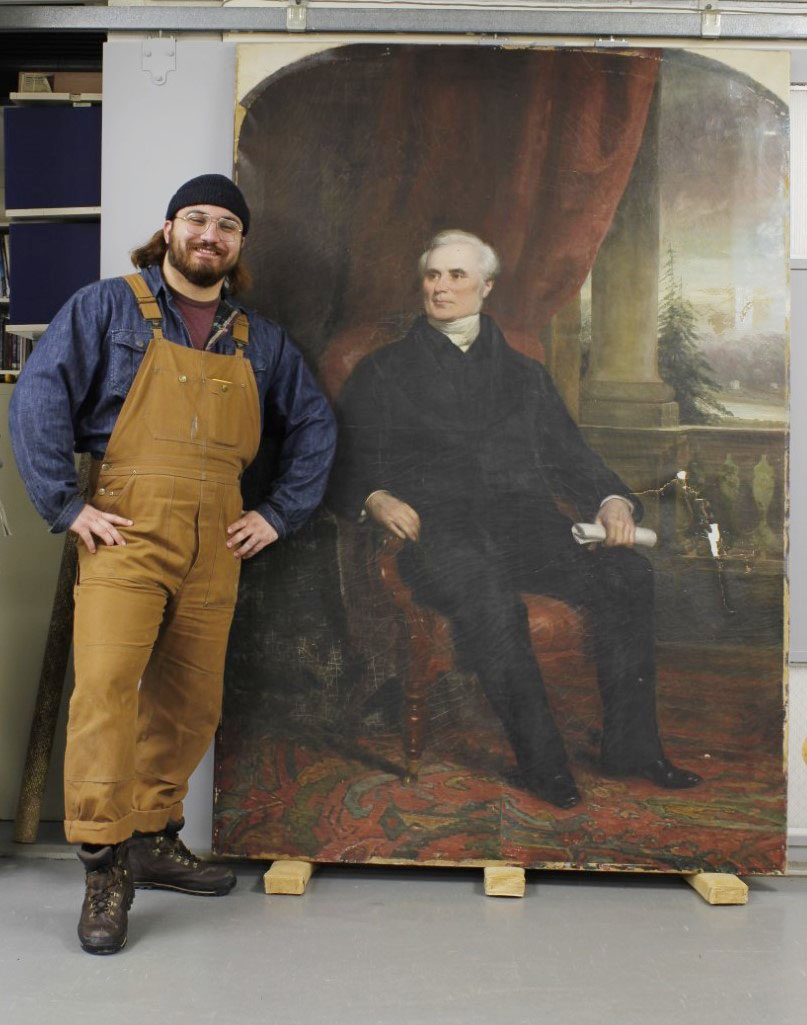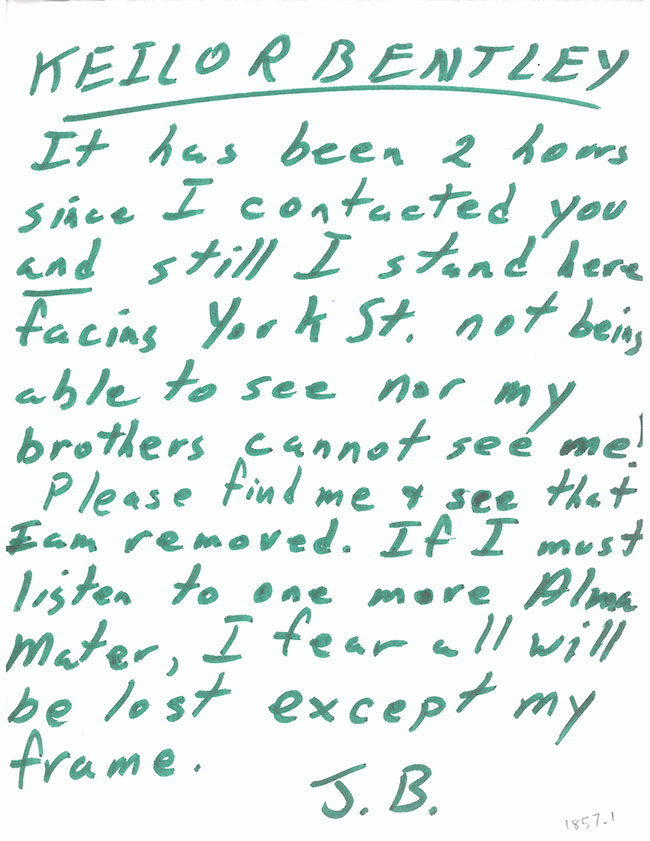The mysterious Mr. Beecham
The portrait of Rev. John Beecham first appeared at Mount Allison in 1857. A commissioned piece by William Gush, it was a companion to a later painting by Gush of Mount Allison founder Charles Frederick Allison. Both were installed above the platform at Lingley Hall, the University’s forerunner to Convocation Hall.
And there the portrait remained — not undisturbed, but we’ll get to that later — for 53 years. Beecham then began a long tour of campus that saw the portrait hung or stored in various places, lost from the written record for a time, and apparently kidnapped before ending up in the Owens Art Gallery, where its story piqued the interest of Colville House Curatorial Intern Jack Symonds (’21).

“Some of our files only note where and when we acquired a piece, but this one has a near 100-year history of being moved around and talked about, so it became very interesting to me to get the whole history down,” says the Fine Arts graduate.
Symonds painstakingly went through the file, then began collecting missing pieces of the puzzle. He started by talking to long-time Owens staff, and Jane Tisdale (’89), fine arts conservator at the Owens, helped him reach out to alumni and retired faculty.
Beecham’s connection to Mount Allison is tangential: he was secretary of the Wesleyan Methodist Missionary Society and wrote to Allison to express support for the establishment of an academy, though noted the Society would not take responsibility for doing so. He became the first President of the Wesleyan Methodist Church of Eastern British America in 1856. As such he visited what was then known as the Mount Allison Wesleyan Academy and sang the school’s praises in his report back to the British conference. The portrait was commissioned and hung at Mount Allison in 1857, and Beecham died shortly thereafter.
But his portrait’s life had just begun.
In its home in Lingley Hall, it partially covered a balcony, which meant the back of the portrait was accessible to anyone seated there. Students began writing their names on the back of the portrait. Some went so far as to cut slits in it, the better to peek into the room. In the late 1880s boards were nailed to the back of the portrait to protect it, but students continued to write their names on the boards until the painting was moved to the Charles Fawcett Memorial Hall (where Convocation Hall now stands) in 1910. Beecham spent two decades in Fawcett Hall, then was moved to the Memorial Library, where he would spend the next 40 years, in both places accompanied by the portrait of Charles Allison.
But then the record gets murky. In 1970 the Memorial Library was undergoing renovations and the portrait was removed. The Allison portrait was sent off for restoration and re-installed in the new R. P. Bell Library; the Beecham portrait was also scheduled to be restored, but never was.
“Part of the mystery of it all is we don’t know now where the portrait was at this point,” Symonds says. “Everyone has different ideas. It was believed to have been moved to the Owens first, but it also might have been in the rafters of the carpenter’s shop or in a storage room in the basement of Convocation Hall.”
Although Owens staff would have known at the time where the painting was, that information is not in the written record. Symonds was not able to determine definitively where it was from 1970 until 1983, when Roxie Ibbitson, registrator/preparator, began working at the Owens and remembers seeing the painting in the gallery’s basement storage area.
What Symonds did uncover was an apparent kidnapping plot.
“Sometime in the late 1970s two letters were sent, about two hours apart, to Keillor Bentley, the then-director of the Owens, through the Mount Allison internal mail system,” he says.
The first one read, in part: “They are finally searching for me. I have been standing here for 6 years! Abandoned! Forgotten! It is so dry my skin has become wrinkled. Please locate me so that I may be hung as my station deserves. Rev. J. Beecham D.D.”

And the second, “It has been 2 hours since I contacted you and still I stand here facing York St. not being able to see nor my brothers cannot see me! Please find me and see that I am removed. If I must listen to one more Alma Mater, I fear all will be lost except my frame. J. B.”
The letters were carefully saved in the Beecham portrait’s file in the Owens, but no further information was available. So, Symonds reached out to alumni.
“Some of the alumni that we contacted said there were a lot of Fine Arts students who were sympathetic to these paintings that were hidden away in storage, so there was a history of taking them out and putting them on display,” he says. “This was also prime pranking time at Mount Allison.”
Of all the unknowns surrounding the portrait, this is the mystery Symonds most wants to solve.
“Whoever did it is likely still very much alive and they may be just a phone call away,” he says. “I really want to know if the portrait was actually moved around campus and the logistics of this operation.”
Whether as a consequence of the kidnapping or not, the Beecham portrait was returned to the Owens in the early 1980s and has been there ever since. Over time Beecham has developed a new and invaluable role: as a learning resource for Fine Arts students.
“When she is mentoring future conservators, Jane (Tisdale) uses this as an example of what can go wrong with a painting,” Symonds says, noting in addition to the writing on the back and the cuts in the canvas, the painting also has damage from being displayed above a radiator.
“The painting has a teaching function now,” explains Emily Falvey (’97), director and curator of the Owens Art Gallery. “It might be worth less to us if it were restored — its history and its role in Jane’s mentorship and teaching is so important. And it also proved valuable to Jack, who learned so much about researching a work of art through this process.”
Symonds’ work is giving Beecham a new chance to shine: for the first time in more than 50 years the portrait will be on public display. The Owens Art Gallery is exhibiting the painting, the kidnapping notes, and a history of the piece from May through July 2022.
“I just really like uncovering things,” Symonds says. “And the history that it has — 165 years at Mount Allison and all the things that have happened to it — it is interesting just in that way.”


